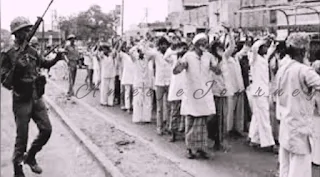The Meerut Riots of May 12, 1987: A Historical Overview
On May 12, 1987, Meerut, a city in the Indian state of Uttar Pradesh, witnessed one of the darkest chapters in its history, often referred to as the Hashimpura massacre. This event remains a significant point of discussion in the context of communal violence in India and the broader discourse on justice and human rights. Here is a comprehensive exploration of the event, its background, and its aftermath.
Introduction
The Hashimpura massacre stands as a grim reminder of the communal tensions that have occasionally marred India's social fabric. Occurring during a period of heightened communal strife, this incident involved the abduction and subsequent murder of around 42 Muslim men by personnel of the Provincial Armed Constabulary (PAC) of Uttar Pradesh.
Background: Communal Tensions in Meerut
In the 1980s, Meerut was a city rife with communal tension. The years leading up to the massacre had seen several incidents of violence between the Hindu and Muslim communities. Economic disparities, political manipulation, and a series of provocative events had created an atmosphere of suspicion and animosity.
The communal atmosphere in Meerut was further strained by the Ram Janmabhoomi movement, which aimed to build a temple at the site believed to be the birthplace of Lord Ram in Ayodhya. This movement, spearheaded by various Hindu nationalist groups, exacerbated the existing Hindu-Muslim divide across northern India, including Meerut.
The Immediate Precipitating Events
In April 1987, riots erupted in Meerut, leading to widespread violence, arson, and looting. Several people were killed, and many were injured. The violence was primarily communal, with both Hindus and Muslims suffering significant casualties and losses.
The state government, struggling to control the situation, deployed additional security forces, including the PAC, to maintain order. However, the communal bias within the security forces, particularly the PAC, became evident as they were accused of targeting Muslims during the operations.
The Hashimpura Incident
On May 12, 1987, the PAC conducted a raid in the Hashimpura locality of Meerut, predominantly inhabited by Muslims. Under the pretext of conducting a routine search operation to seize illegal weapons and arrest suspected rioters, the PAC personnel rounded up around 50 Muslim men, aged between 18 and 55 years.
These men were loaded onto a truck and taken to the Upper Ganga Canal near Murad Nagar in Ghaziabad district. Here, in a shocking display of brutality, the PAC personnel shot them at close range and dumped their bodies into the canal. Some of the victims survived the shooting and managed to escape, later recounting the horror they had endured.
The Aftermath
The massacre left a deep scar on the community and the city. Families of the victims were left devastated, grappling with the sudden and violent loss of their loved ones. The incident led to widespread outrage and condemnation from various quarters, including human rights organizations, political leaders, and civil society.
Despite the gravity of the crime, the path to justice was long and arduous. The survivors and the families of the victims faced immense challenges in their quest for justice. The investigation into the massacre was marred by delays, inefficiencies, and alleged attempts to protect the perpetrators.
Legal Battle and Struggle for Justice
The legal battle for justice in the Hashimpura massacre case was protracted and fraught with challenges. In 1996, nine years after the incident, charges were finally filed against 19 PAC personnel. The trial, however, moved at a snail's pace, with numerous delays and adjournments.
In 2002, the case was transferred from Ghaziabad to a sessions court in Delhi to ensure a fair trial. The trial continued for several more years, with the prosecution presenting evidence and witness testimonies to establish the guilt of the accused PAC personnel.
In March 2015, 28 years after the massacre, a Delhi sessions court acquitted all 16 surviving accused due to insufficient evidence. This verdict was met with widespread disappointment and anger from the victims' families and human rights activists. The acquittal highlighted the systemic issues within the judicial process and the challenges faced in holding state actors accountable for their actions.
Appeal and Conviction
The acquittal was appealed in the Delhi High Court. In October 2018, the High Court overturned the acquittal and convicted 16 former PAC personnel, sentencing them to life imprisonment for their roles in the massacre. The court's judgment was seen as a significant step towards justice, albeit delayed.
The conviction brought some solace to the victims' families, although it could not erase the pain and suffering endured over the decades. The judgment also underscored the importance of accountability and the need for reforms within the law enforcement and judicial systems to prevent such miscarriages of justice in the future.
Broader Implications and Reflections
The Hashimpura massacre is not just a tragic episode in Meerut's history but also a stark reminder of the deep-seated communal tensions and biases that can pervade state institutions. It raises critical questions about the role of law enforcement agencies in a pluralistic society and the mechanisms needed to ensure their accountability.
The incident also highlights the importance of a robust and independent judicial system that can deliver timely and impartial justice. The long delay in securing justice for the Hashimpura victims points to systemic issues that need to be addressed to prevent similar occurrences in the future.
Conclusion
The events of May 12, 1987, in Meerut are a poignant chapter in India's history, reflecting the devastating impact of communal violence and the challenges in achieving justice for the victims. While the eventual conviction of the perpetrators provided a measure of justice, the prolonged legal battle underscored the need for systemic reforms.
The Hashimpura massacre remains a powerful reminder of the importance of communal harmony, the protection of human rights, and the necessity for accountability within state institutions. It serves as a call to action for ensuring that such tragedies are not repeated and that justice is not delayed for those who suffer from such heinous acts.



